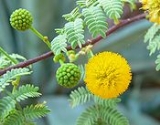
Acacia constricta
Encyclopedia


Acacia
Acacia is a genus of shrubs and trees belonging to the subfamily Mimosoideae of the family Fabaceae, first described in Africa by the Swedish botanist Carl Linnaeus in 1773. Many non-Australian species tend to be thorny, whereas the majority of Australian acacias are not...
shrub
Shrub
A shrub or bush is distinguished from a tree by its multiple stems and shorter height, usually under 5–6 m tall. A large number of plants may become either shrubs or trees, depending on the growing conditions they experience...
native to Mexico
Mexico
The United Mexican States , commonly known as Mexico , is a federal constitutional republic in North America. It is bordered on the north by the United States; on the south and west by the Pacific Ocean; on the southeast by Guatemala, Belize, and the Caribbean Sea; and on the east by the Gulf of...
and the southwestern
Southwestern United States
The Southwestern United States is a region defined in different ways by different sources. Broad definitions include nearly a quarter of the United States, including Arizona, California, Colorado, Nevada, New Mexico, Oklahoma, Texas and Utah...
United States
United States
The United States of America is a federal constitutional republic comprising fifty states and a federal district...
.
It typically grows to 2 meters in height, occasionally reaching 3 m. Its stems range from a light gray to a mahogany color, with pairs of straight white spines anywhere from 0.5 to 2 cm long. The small leaves are even-pinnate
Pinnate
Pinnate is a term used to describe feather-like or multi-divided features arising from both sides of a common axis in plant or animal structures, and comes from the Latin word pinna meaning "feather", "wing", or "fin". A similar term is pectinate, which refers to a comb-like arrangement of parts...
, typically 2.5-4 cm in length, with each of the 3-9 pairs of pinnae made of 4-16 pairs of leaflets, which are about 3.5 mm long and 1 mm wide. The flowers occur in small yellow balls about 1 cm in diameter. The pods are relatively long and thin, up to 12 cm long but only 3-6 mm wide.
In the Sonoran Desert
Sonoran Desert
The Sonoran Desert is a North American desert which straddles part of the United States-Mexico border and covers large parts of the U.S. states of Arizona and California and the northwest Mexican states of Sonora, Baja California, and Baja California Sur. It is one of the largest and hottest...
, it is usually found in arroyos and washes, where it blooms in late spring (April-May), with a second round of blooms in July-October. The bloom depends on having a minimum amount of rain, followed by a period of warmth. The flowers offer no nectar and little pollen, and so tend to have few visitors.
In Arizona
Arizona
Arizona ; is a state located in the southwestern region of the United States. It is also part of the western United States and the mountain west. The capital and largest city is Phoenix...
, it is found throughout the southern half of the state, extending southward throughout Sonora
Sonora
Sonora officially Estado Libre y Soberano de Sonora is one of the 31 states which, with the Federal District, comprise the 32 Federal Entities of Mexico. It is divided into 72 municipalities; the capital city is Hermosillo....
. Small disjunct populations have been collected from Baja California
Baja California
Baja California officially Estado Libre y Soberano de Baja California is one of the 31 states which, with the Federal District, comprise the 32 Federal Entities of Mexico. It is both the northernmost and westernmost state of Mexico. Before becoming a state in 1953, the area was known as the North...
and Baja California Sur
Baja California Sur
Baja California Sur , is one of the 31 states which, with the Federal District, comprise the 32 Federal Entities of Mexico. Before becoming a state on October 8, 1974, the area was known as the South Territory of Baja California. It has an area of , or 3.57% of the land mass of Mexico and comprises...
, the latter from the Magdalena Plain.
The leaves may drop in response to either dryness or cold.
A. constricta sees some use in desert gardens; it can be trained into barriers or as a tree.
Varieties
- Acacia constricta var. constricta
- Acacia constricta var. paucispina
General References
- Raymond M. Turner, Janice E. Bowers, and Tony L. Burgess, Sonoran Desert Plants: an Ecological Atlas (Tucson: The University of Arizona Press, 1995) pp. 15-16

